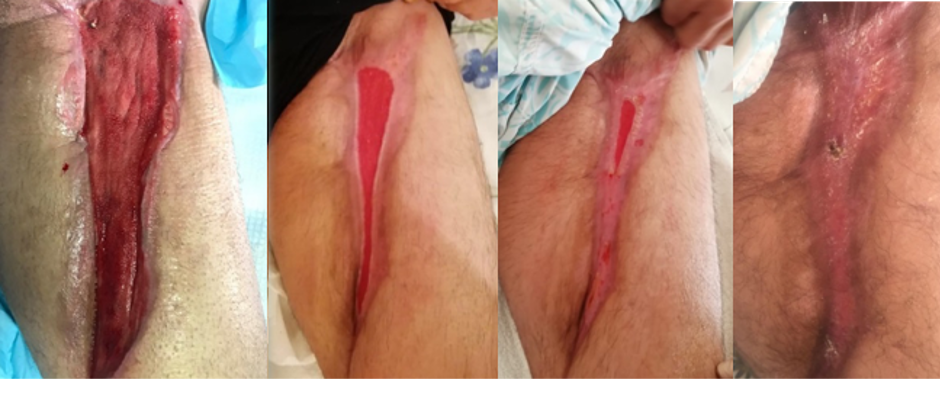Necrotizing Fasciitis Causing Complete Femoral Vessels Necrosis and Thrombosis in an Intravenous Drug Abuser: A Case Report
DOI:
https://doi.org/10.38179/ijcr.v2i1.28Keywords:
Necrotizing fasciitis, intravenous drug abusers, rare case, case report, vascular surgery, ilio-femoral anastomosisAbstract
Background: Intravenous drug abuse is an anciently known health and social problem worldwide. The nonsterile application of addicting drugs leads to severe life-threatening vascular complications. The femoral triangle is an easy target for this purpose. Groin necrotic fasciitis (NF) with vessel necrosis is a challenging diagnosis that requires prompt treatment.
Case Report: A 44-year-old male intravenous drug user presented for a left groin pain. He was diagnosed by computed tomography scan to have necrotizing fasciitis. Urgent debridement was performed and identified infected and necrotic ruptured femoral vessels without active bleeding. Debridement with vessel ligation was performed, and delayed revascularization was planned. The patient was admitted six weeks later with a left fifth toe necrosis and delayed arterial revascularization was performed via extra-anatomic trans-obturator ilio-femoral anastomosis. The patient had a favorable follow-up.
Conclusion: NF in intravenous drug abusers should always be taken into consideration when a patient presents with groin pain and swelling. Urgent surgical control should be established. Extra-anatomical trans-obturator ilio-femoral anastomosis is a good option for revascularization.
References
Behera C, Naagar S, Krishna K, Taraporewalla DR, Garudadhri GV, Prasad K. Sudden death due to ruptured pseudoaneurysm of femoral artery in injected drug abusers - report of four cases at autopsy and review of literature. J Forensic Leg Med. 2014;22:107-111. PMID: 24485433. https://doi.org/10.1016/j.jflm.2013.12.010
Mittapalli D, Velineni R, Rae N, Howd A, Suttie SA; East of Scotland Vascular Network. Necrotizing soft tissue infections in intravenous drug users: a vascular surgical emergency. Eur J Vasc Endovasc Surg. 2015;49(5):593-599. PMID: 25805328. https://doi.org/10.1016/j.ejvs.2015.02.002
Samarakoon LB, Ho DCY, Tan YK, Kum SWC, Lim DM. Infected femoral pseudoaneurysms in intravenous drug abusers: a decade of experience from a Singapore tertiary centre. Singapore Med J. 2021;62(3):135-138. PMID: 32147737. https://doi.org/10.11622/smedj.2020011
Hemdan MA, Ewida AM, Metwally YH. Surgical Management of the Infected Femoral Pseudoaneurysms In Intravenous Drug Addicts. The Egyptian Journal of Hospital Medicine. 2018;72(5):4539-4542. https://doi.org/10.21608/ejhm.2018.9541
Qiu J, Zhou W, Zhou W, et al. The Treatment of Infected Femoral Artery Pseudoaneurysms Secondary to Drug Abuse: 11 Years of Experience at a Single Institution. Ann Vasc Surg. 2016;36:35-43. PMID: 27427346. https://doi.org/10.1016/j.avsg.2016.03.030
Al Shukry S, Ommen J. Necrotizing Fasciitis - report of ten cases and review of recent literature. J Med Life. 2013;6(2):189-194. PMID: 23904882
Naqi SA, Khan HM, Akhtar S, Shah TA. Femoral pseudoaneurysm in drug addicts--excision without revascularization is a viable option. Eur J Vasc Endovasc Surg. 2006;31(6):585-587. PMID: 16466941. https://doi.org/10.1016/j.ejvs.2005.12.011
Rammell J, Kansal N, Bhattacharya V. Management options in the treatment of femoral pseudoaneurysms secondary to intravenous drug abuse: A case series. Int J Surg Case Rep. 2017;36:30-33. PMID: 28528282.https://doi.org/10.1016/j.ijscr.2017.04.024
Huang WS, Hsieh SC, Hsieh CS, Schoung JY, Huang T. Use of vacuum-assisted wound closure to manage limb wounds in patients suffering from acute necrotizing fasciitis. Asian J Surg. 2006;29(3):135-139. PMID: 16877210. https://doi.org/10.1016/s1015-9584(09)60072-5
Bath J, Rahimi M, Long B, Avgerinos E, Giglia J. Clinical outcomes of obturator canal bypass. J Vasc Surg. 2017;66(1):160-166. PMID: 28216364. https://doi.org/10.1016/j.jvs.2016.11.049

Published
How to Cite
Issue
Section
Copyright (c) 2021 International Journal of Clinical Research

This work is licensed under a Creative Commons Attribution 4.0 International License.







